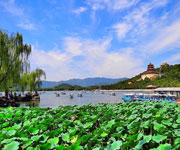The imperial Chinese garden, illustrated by the Summer Palace, is a potent symbol of one of the major world civilizations. The Summer Palace epitomizes the philosophy and practice of Chinese garden design, which played a key role in the development of this cultural form throughout the east. Between 1750 and 1764 the Qing Emperor Qianlong created the Garden of Clear Ripples (Summer Palace), extending the area of the lake and carrying out other improvements based on the hill and its landscape. During the Second Opium War (1856-60) the garden and its buildings were destroyed by the allied forces. Between 1886 and 1895 it was reconstructed by Emperor Guangxu and renamed the Summer Palace, for use by Empress Dowager Cixi. It was damaged in 1900 by the international expeditionary force during the suppression of the Boxer Rising and restored two years later. It became a public park in 1924.
The Summer Palace
The Summer Palace covers an area of 2.97 km2, three-quarters of which is covered by water. The main framework is supplied by the Hill of Longevity and Kunming Lake, complemented by man-made features. It is designed on a grandiose scale, commensurate with its role as an imperial garden. It is divided into three areas, each with its particular function: political and administrative activities, residence, and recreation and sightseeing.The political area is reach by means of the monumental East Palace Gate. The central feature is the Hall of Benevolence and Longevity, an imposing structure with its own courtyard garden. This area connects directly with the residential area, which is made up of three complexes of buildings. The Hall of Happiness in Longevity was the palace of Cixi and the Hall of Jade ripples that of Guangxu and his empress, whereas the Hall of Yiyun housed his concubines. These buildings are all built up against the Hill of Longevity, with fine views over the lake, and are connected to one another by means of roofed corridors. These communicate with the Great Stage to the east and the Long Corridor (728 m), with more than 10,000 paintings on its walls and ceilings, to the west. In front of the Hall of Happiness in Longevity there is a wooden quay giving access by water to their quarters for the imperial family. The remainder of the Summer Palace, some 90% of the total area, is given over to recreation and sightseeing. The steeper northern side of the Hill of Longevity is a tranquil area, through which a stream follows a winding course.











No comments:
Post a Comment